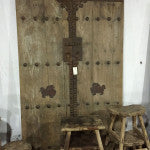
Some favourite Chinese antiques from my recent trip to Beijing
I have finally had a chance to draw breath after my trip to China earlier this month, so I thought now would be a good time to share some of the favourite antique pieces I selected from our various suppliers in Beijing when I was over there.
I should say first of all that it has become more and more difficult over the 12 years since I started Shimu to find good quality antiques. Ten or fifteen years ago there were many workshops across the city that would source furniture from their own network of suppliers throughout northern China, or buy from the unrestored antique furniture markets in Beijing, before carrying out restoration and selling on for export. Nowadays most of these workshops have either disappeared or now only produce new furniture, as the supply of antiques has dwindled. Particular styles and types of furniture that were easy to come by when we started up are now quite rare.
The situation is partly down to lack of supply, as there is only a finite amount of quality antique furniture available, particularly as so much was destroyed during the Cultural Revolution. As the amount of unrestored pieces has diminished and they have become fewer and farther between, it has also become harder and more costly for the network of suppliers out in China’s regions to gather these items ready for sale to the restorers. This means that fewer people are interested in this line of work, particularly compared to the perceived potential riches of an alternative job in one of China’s rapidly growing cities. Despite this it IS still possible to find good quality pieces, and on each visit so far I have always managed to find a few standout items that I can’t wait to ship back to the UK.
We now work with three or four small workshops that still have a good source of antiques and are skilled at restoring them. The finest pieces, in the most original condition, are usually finished so as to show the old colour and details as much as possible. Other pieces might be stripped down and given a completely new lacquer finish, essentially breathing new life into an old, possibly unloved piece of furniture.
| Shanxi Book Cabinet | Detail of Carving from Shanxi Book Cabinet | Antique Chinese Doors |
| Antique Chinese Doors Hardware | Camphor Trunk | Pair of Blue Lacquer Medicine Chests |
The red lacquer two door cabinet shown here is typical of a piece that used to be reasonably common but has now become rare. Antique furniture from the central province of Shanxi, where this piece originated, is well known in China for its quality and, at one time, abundance. Cut off from much of China by mountains and rivers, Shanxi suffered less than other parts of the country during the Cultural Revolution and so the beautiful painted armoires and cabinets that it is famous for survived the ravages of that period better than most. Nowadays though, it is rare to find a cabinet like this one, particularly one with its old lacquer and such beautifully detailed carvings on the base. These include delicate flowers and birds as well as a bat at each side to represent good luck.
The pair of large elm doors are one of several pairs available through one of our regular suppliers. I have often thought that these would make a fantastic, imposing entrance mounted in a modern setting, or even used just as decorative elements on a wall. I’ve also seen many of them converted into large coffee tables. You’d need plenty of space to make this work but the old iron handles, large heavy studs and weathered elm wood provide real character.
Camphor chests used to be plentiful when Shimu started up around twelve years ago. I remember our first few shipments of Chinese antique furniture all included a few of these and they always sold quickly. Over recent visits to Beijing, though, I’ve seen fewer and fewer. Used throughout China for storing clothes and bedding, camphor wood has a menthol-like aroma that acts as a natural insect repellent and the wood has a lovely tone and character. The chests are great as toy boxes or blanket trunks in a bedroom, and are also often perfectly sized for use as coffee tables with handy storage space inside. This particular chest also has its original brassware, including the front clasp and studded side brackets.
Lastly, the pair of mutidrawer chests in blue lacquer shown here is a good example of the ‘new from old’ furniture that I mentioned earlier, where an antique piece has been adapted and refinished to produce something more practical in a modern setting. These two chests started life, again in Shanxi, as one large medicine chest used by a Chinese apothecary. The original chest was cut and put back together as the two smaller pieces seen here, which were then refinished in a more modern shiny blue lacquer. Whilst the result bears little relation to the original piece of furniture, the new chests would look wonderful in a modern home office or bedroom.
These are just a few examples from the eighty or so antiques that I selected over in China and which we will be shipping over the coming weeks to arrive here in our showroom in the new year, so look out for the full collection soon in the New Arrivals section of our website. We’ll also post photographs on our Facebook page as soon as we have these so, if you haven’t already, please ‘like’ us to get a an early view of what we have lined up!











Leave a comment